Hands On with USB Type C: Reversible USB Connectors
by Joshua Ho on September 11, 2014 9:00 AM EST- Posted in
- Smartphones
- Mobile
- Laptops
- Tablets
- USB-IF
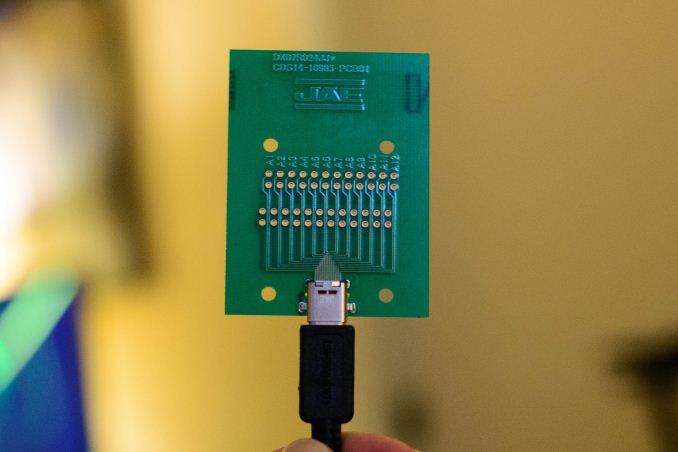
Today, the USB-IF brought me in to see the long-awaited USB Type C cables. We've written about this before, but for those that aren't familiar with this new USB spec, the USB Type C cable and USB 3.1 spec are designed with the future in mind. As a result, there are a lot of new features to talk about. We'll start with the USB 3.1 spec before we get into the Type C connector.
With USB 3.1, we see a few key improvements. Peak throughput goes to 10 Gbps from 5 Gbps, which translates to a peak of 1.25 GB/sec. In a demo of an early controller with two SSDs attached to the system I saw peak throughput of 833 MB/sec. As a side note, I also saw a demo of wireless USB connectivity from smartphone to laptop and laptop to smartphone, which was definitely pretty cool. Getting back to the USB 3.1 spec, USB Power Delivery 2.0 (PD) makes it possible for USB to supply up to 100 watts, and coexists with the BC 1.2 spec that is used in USB power adapters to charge phones so a single port would be able to provide power for both systems. In addition, USB PD 2.0 allows for power to go both ways without changing the direction of the cable, so a laptop would be able to send and receive power from the same port. Finally, USB Type-C extensions mean that it's possible to do all kinds of interesting applications over USB ports, such as sending audio and video data. It's even possible for a USB Type C port to send PCI-E data through the connection for use cases such as a two in one convertible tablet.
This opens up the possibility for a dock scenario where a single cable to the monitor can charge a laptop and also mirror the laptop's display onto the external monitor, and the external monitor would also be able to serve as a USB hub for a keyboard, mouse, headsets, flash drives, and other USB peripherals. While the laptop charging aspect and integrated USB hub in display wasn't demonstrated in the prototype I saw, everything else was fully working as shown in the photo above.
I was also able to get some photos of the cable and receptacle. Unfortunately it took flash to really show the detail in the connector but it definitely will be a great standard for all kinds of applications. While I'm sure that there will be differences in the final product, the reversible plug works just like expected and could be quickly inserted from behind the back. The USB-IF believes that this standard will show up in products shipping in 2015. It does seem that the connector is a bit less compact than microUSB, but the benefits outweigh this increase in size.


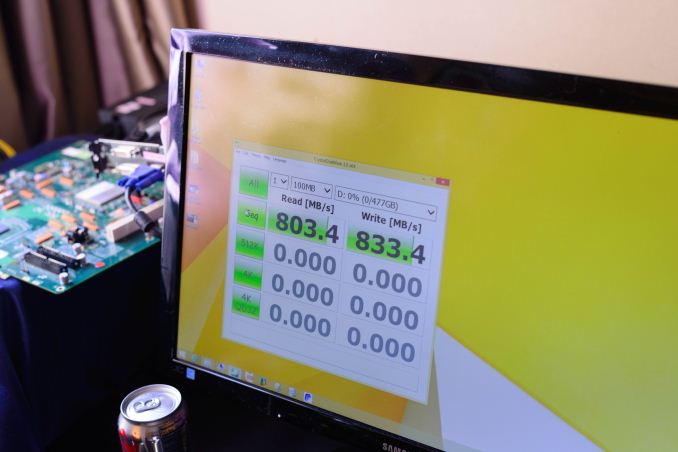
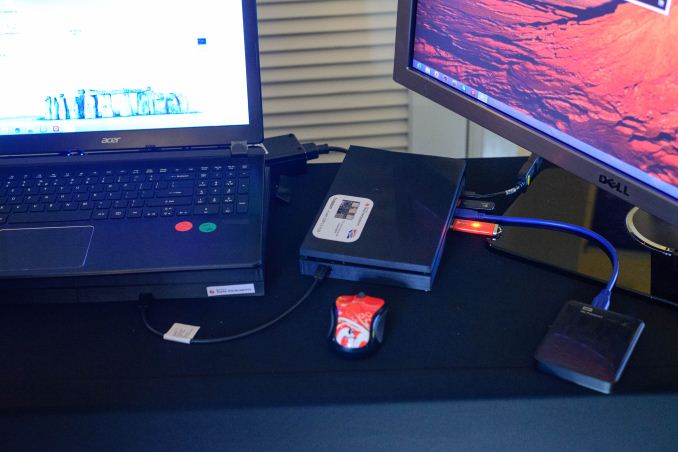
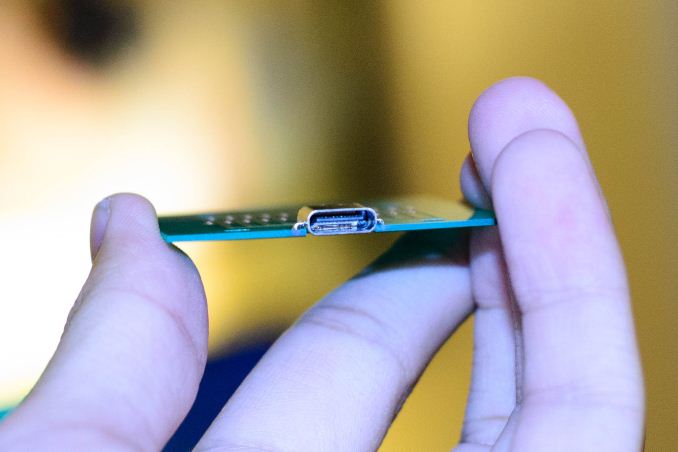
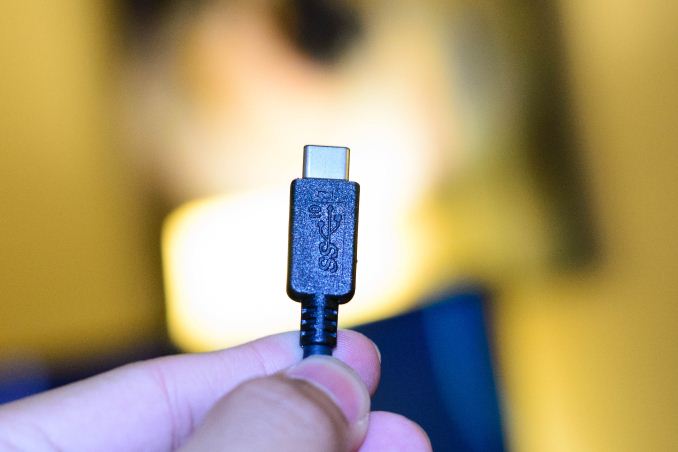
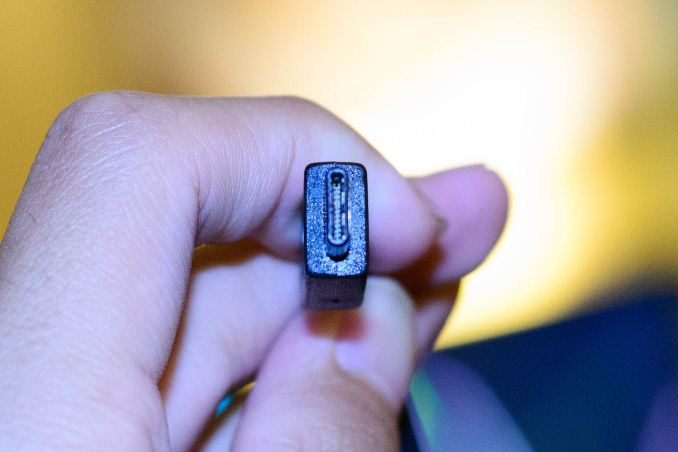








91 Comments
View All Comments
R3MF - Wednesday, September 17, 2014 - link
"That said, is there a reason not to design it like a lightning style connector where the male plug first and fills the female port completely without any weak points in the connection?"Oxidation of the exposed terminals.
Fergy - Friday, September 12, 2014 - link
Will this replace all usb connectors? Will we get motherboards with usb-c? Hubs? Keyboard, mouse and usbstick with usb-c? I hope so because those ports are irritating.fluxtatic - Friday, September 12, 2014 - link
Eventually, yes. But it'll come to the high-end first - Asus' ROG boards, AsRock's Extreme series, etc. Last I checked, prebuilt mass-market PCs still don't commonly have USB3.metayoshi - Friday, September 12, 2014 - link
I can't speak for pre-built desktops, but to my knowledge, most mainstream laptops have been coming out with at least one USB 3.0 port since the Ivy Bridge days.DanNeely - Saturday, September 13, 2014 - link
At this point it's worked its way down to bottom end laptops. I looked on Newegg and found a $199 Chrome Book and $239 windows laptop; both with at USB3 on one side.isa - Friday, September 12, 2014 - link
Joshua, thanks for the review. It would be great if you could consider a follow-up review or article or addendum to this article discussing how stress and connection failures of previous microUSB connector specs have been solved or not with 3.1-C. More specifically, in previous USB connector implementations, most notoriously in microUSB, stresses in the connector were directly transferred to the solder joints in the microUSB connections on the PCB board. So if one wiggled the microUSB insert in any way, or failed to create an ad-hoc stress relief method for any microUSB cable inserted into a device (tape, cardboard, etc), then the stress of the connection would be directly transferred to the PSB solder joints and eventually fail.Has this issue been robustly solved with USB 3.1 C?
LordConrad - Saturday, September 13, 2014 - link
Maybe I'm smarter than the average person, but I don't understand why a reversible connector is such a big deal. I frequently plug in my android phone or tablet to charge in the dark and never have any issues. Do people seriously have problems with this??Fergy - Monday, September 15, 2014 - link
So how do you do it without seeing anything? Do you feel with your fingers to find the port and the orientation? Do you then feel the connector and the orientation? Compare that to doing the same with a mini-jack.If you think it has anything to do with intelligence you are pretty dumb.
beggerking@yahoo.com - Tuesday, September 16, 2014 - link
just try pluging it in.. if it doesn't work, turn it around and plug it in again... pretty easy..besides, with qi charging becoming more wide spread, there is less need for plugging in.
tuxRoller - Tuesday, September 16, 2014 - link
Was UAS being used?